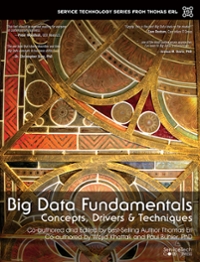Answered step by step
Verified Expert Solution
Question
1 Approved Answer
( please draw it out as well also do not forget the specializations and jointness constraints ) Please develop an EER Model for the following
please draw it out as well also do not forget the specializations and jointness constraints Please develop an EER Model for the following situation. Your EER diagram must be
complete, meaning that all necessary information must be presented. Make appropriate
assumptions if necessary and clearly state them. The appropriateness of your assumption
will be evaluated.
Hints: Are provided to help you form your logic. Please be advised such helpful hints
may not be present for your project or exams. So please learn and clear any questions
now.
Upload the PDF file of your EER models by the due date and time
Situation
An International School of Technology IST has hired you to create a database system to
assist in its daily operation. After several interviews with the administrators, you have
come up with the following list of entities, attributes, and initial business rules:
IST depends on a large number of employees for its continued success. There are
three groups of employees on whom IST is most dependent: Administrators,
Instructors and Staff. Some common attributes are shared by all employees: EmpID
identifier Name, Address, CityStateZip BirthDate, and Phone.
Hint: Is this a supertype subtype situation?
Hint: Where does the common attributes go
Hint: Could there be employees other than the three most dependent groups?
Each of the three groups of employees has at least one unique attribute of its own.
Staffs have Certificate, Instructors have Expertise and Rank, and Administrators have
position. An employee must belong to at least one of these groups.
Hint: Can an employee belong to more than one group?
Room is identified by BuildingID and RoomNO and also has a Capacity. There are
the two different kinds of rooms: Classroom and Office. At a given time, a room must
be exactly one of these subtypes. An office may be shared by multiple employees, but
an employee cannot have more than one office.
Hint: Try to use the above hints & and apply them to this situation.
Timeslot has identifier TSIS and has attributes DayofWeek, StartTime, and EndTime.
Course has identifier CourseID and has attributes CourseDescription and Credits.
Courses can have one, none, or many prerequisites. Courses also have one or more
sections.
Hint: What kind of a relationship is prerequisiteunary binary or ternary
Hint: Would the prerequisite of a course be present in the course table?
Section has identifier SectionID and an attribute EnrollmentLimit.
After some further discussions, you have come up with some additional business rules to
help you create the initial design:
A section can be scheduled for no classroom or many classrooms for semesters.
However, one classroom can participate in many schedules, one schedule, or no
schedule; one time slot can participate in many schedules, one schedule, or no
schedules. You are required to keep track of semester and years of each schedule.
Hint: What kind of a relationship is scheduleunary binary, or ternary
Hint: How many entities are required to schedule?
Hint: How do you keep track of schedule details? Is there an entity specifically for
this purpose?
An instructor teaches one, none, or many sections of a course scheduled in a
particular semester. Each section of a course scheduled in a seminar has only one
instructor.
Step by Step Solution
There are 3 Steps involved in it
Step: 1

Get Instant Access to Expert-Tailored Solutions
See step-by-step solutions with expert insights and AI powered tools for academic success
Step: 2

Step: 3

Ace Your Homework with AI
Get the answers you need in no time with our AI-driven, step-by-step assistance
Get Started


